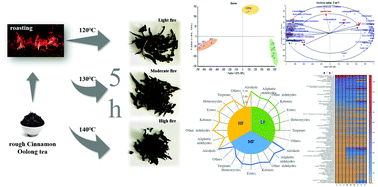Differences of characteristic aroma compounds in Rougui tea leaves with different roasting temperatures analyzed by switchable GC-O-MS and GC × GC-O-MS and sensory evaluation†
Abstract
Roasting, an important process to refine Wuyi Rock tea, could impart different types of aroma to the final products. This study focuses on the differences in aroma characteristics among three kinds of refined teas, named light fire (LF), moderate fire (MF), and high fire (HF). A combination of solid phase microextraction (SPME) and a switchable system between GC-O-MS and GC × GC-O-MS was utilized to identify the odorants. In total, 97 aroma-active compounds could be smelled at the sniffing port, comprising alcohols, aldehydes, ketones, esters, heterocycles, and terpenes. However, only 52 obtained r-OAV >1. Significant differences were uncovered by the application of principal component analysis (PCA) and partial least squares regression (PLSR). Thereby, MF and HF had a more similar aroma profile, while in LF samples, alcohols, aliphatic aldehydes and some ketones were responsible for the aroma profile, such as (E,E)-2,4-hexadienal, octanal, hexanal, (E,Z)-2,6-nonadienal, (E)-β-ionone, 3-octen-2-one etc. Strecker aldehydes had a great impact on the aroma of MF, including 2-methylpropanal, 2-methylbutanal, 3-methylbutanal etc. Some N-heterocyclic compounds also affected the overall aroma, for instance, 6-methyl-2-ethylpyrazine. In HF, the majority of aroma compounds increased with increasing roasting temperature, especially N-heterocyclic compounds as well as furfural and 5-methyl-2-furancarboxaldehyde, which are all closely related to the Maillard reaction. Besides, 5-methyl-2-(1-methylethenyl)-4-hexen-1-ol, trans-linalooloxide and 2-nonanone also remarkably influenced the aroma of HF. In addition, it was supposed that most amino acids that participated in the Maillard reaction during roasting were decomposed from the compounds that combined with tea polyphenols and amino acids.



 Please wait while we load your content...
Please wait while we load your content...